What is a split system: device and principle of operation of typical air conditioning systems
Everyone who tried to solve the problem of air cooling in a house or apartment has at least a rough idea of what a split system is. This air conditioning option confidently replaced the ancient “windows” and remains popular for many years.
Understanding the features of the split system will allow you to choose the right model and properly organize its operation.
In this material we will talk about the device and the principles of operation of split systems, as well as we will talk about the intricacies of installation, which must be observed in order for the equipment to last for many years.
The content of the article:
The essence of the work and the principle of action
The main purpose of the split system is to cool indoor air. The unit consists of two parts. One of them is installed outside the room, and the other inside. To connect them with a narrow pipe, a hole is made in the thickness of the wall. The principle of operation of split systems is approximately the same as that of refrigerators.
The refrigerant circulating through the tube inside the system absorbs the heat of the air that is inside the room, transfers the heat energy to the outside and returns it to the environment. The air conditioning refrigeration circuit includes two main elements: a condenser and an evaporator.
The first of them is enclosed in the outdoor unit of the device, and the last is in the unit that is installed in the room.
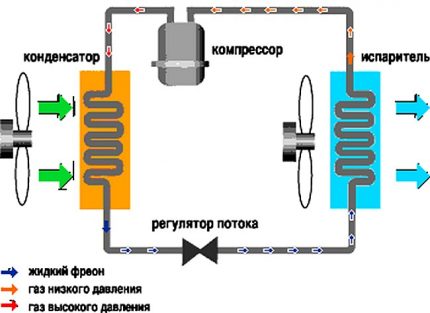
Refrigerant (usually Freon) moves between devices in a closed loop. Indoors, it heats up in the process of absorption of thermal energy and becomes a gas.
In this way, the air cools as it passes through the evaporator. To improve the movement of air flow throughout the room, a fan is used.
Then the refrigerant enters the condenser.Here it passes through a compressor and then cools, in contact with the colder air of the street. The refrigerant becomes liquid again.
The principle of operation of such a system corresponds to the operation of a conventional refrigerator, the ability of freon to evaporate at low temperatures is also used here.
Split system device
To the process of functioning of such an air conditioner was carried out effectively, a number of elements are used.
The outdoor unit usually includes:
- fan;
- compressor;
- capacitor;
- Freon filter
- control board;
- protective cover;
- fittings for copper pipes, etc.
The fan provides constant air circulation around the unit to ensure fast and stable cooling of freon. This process takes place in a capacitor. With the help of the compressor, Freon is compressed, which ensures its transition to a gas state and circulation through the refrigeration circuit.
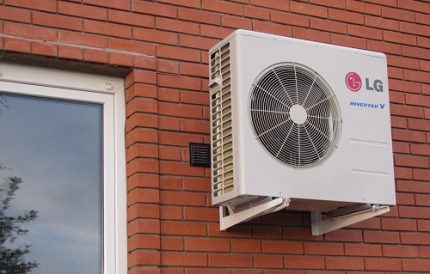
The filter cleans the freon from contaminants that have entered the system, which can occur during installation.
In addition to the mentioned elements, a four-way valve can also be installed in the outdoor unit, which is necessary if the model provides not only cooling, but also heating the room in winter.
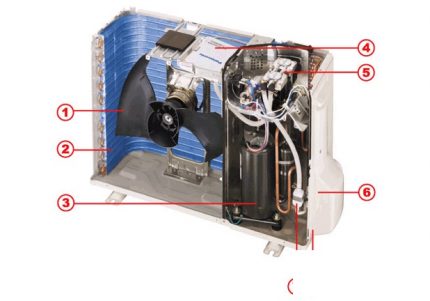
AT inverter models the control unit is almost completely located in the outer part of the device. But if the inverter is missing, the electronics are usually installed in the indoor unit.
This part usually consists of:
- protective grill;
- filter systems;
- a fan;
- evaporator;
- jalousie;
- indicator panel;
- control unit;
- connector fittings, etc.
The protective grill is usually located on the front panel.It is easy to remove or open to gain access to the maintenance of the internal elements of the air conditioner. Through the openings of this grate, air enters the device for further cooling.
The coarse filter is just a plastic mesh that traps large debris so that it does not get into the block body.
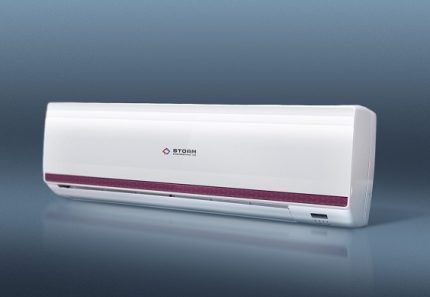
Fine filters are a slightly more complex system for retaining contaminants of fine fractions: dust particles, undesirable odors, dangerous bacteria, etc.
Typically, a device is equipped with a carbon and electrostatic filter, but can be equipped with an antibacterial cartridge or other useful filters.
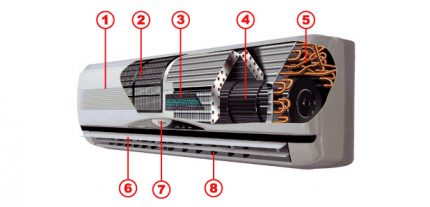
The fan, as mentioned earlier, pumps the cooled air that passes through the evaporator. The movable blinds are equipped with an electric drive to regulate the direction of flow of chilled air.
A panel with indicators displays the status of the device, for example, the set air temperature, operating mode, etc.
This is a general description of a split system device. The design of such air conditioners may vary depending on additional functions: the presence of an inverter, heating, etc. For a room or apartment, an ordinary air conditioner is enough. The device is selected depending on the power, which should correspond to the area of the room.
Types, types, additional functions
Modern household air conditioners are capable of serving up to 90 square meters. m. But if we are talking about a large cottage or office, it makes sense to think about installing more productive devices. The problem of conditioning such objects is solved using multisplit systems or semi-industrial models.

The multisplit system makes it possible to install several indoor units that are connected to one common outdoor unit. Economically, such a solution may turn out to be more profitable than using several conventional split systems, the appearance of the facade definitely wins.
An alternative to solving the air conditioning problem of a large building could be chiller fan coil system. If the area of the office or cottage is approaching the size of 500 square meters. m or slightly exceeds it, it makes sense to think about using a split system of a semi-industrial type.
The channel version of such a device allows you to mount the device and the channel leading to it under a false ceiling without harming the appearance of the room. These devices are able not only to clean and cool the air available in the room, but also to take fresh mass from the outside, which significantly improves the microclimate.
Cassette air conditioners are installed so that the grille through which air is supplied becomes part of the suspended ceiling. Cold air spreads around the room quickly and evenly. Read more about the principles of cassette splits. Further.
In rooms of complex shape or where there is no suspended ceiling for some reason, floor-ceiling systems are installed.
What you need to know about inverter models?
There are models of split systems with and without inverters. Both options are popular, but the difference still does not hurt to find out. An inverter is a device that can provide special power to the compressor.
The inverter circuit is to convert alternating current to direct current.
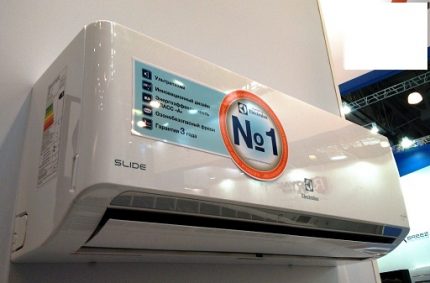
After that, the characteristics of the direct current are changed in order to convert it again to alternating current, but with new indicators, and transfer power to the compressor.
As a result, the compressor operation power will vary depending on the situation: a comfortable temperature to which it is necessary to cool the air and the initial indicators that exist at the time the system starts to work.
If there is an inverter, the air conditioner works constantly, it does not turn off. What is it for? Despite the constant operation of the device, the inverter circuit can reduce power consumption by about 30% than when using a model with similar characteristics, but without an inverter.
The lack of regular on-off cycles favorably affects the functioning of the air conditioner and allows you to increase its life by one and a half to two times. Such an air conditioner can be left on all day without worrying about electricity bills.
High performance is achieved by improving the performance of the heat exchanger, as well as thanks to a modern microprocessor that regulates the operation of the unit.
It is believed that split systems equipped with an inverter are able to quickly establish the optimal temperature in the room and then maintain it at the right level. Such devices produce much less noise than inverter-free counterparts.
There is an article on our website where we conducted a comparative review of inverter and conventional split systems. More details - go to the link.
Air conditioner with heat pump
If the split system is equipped with a heat pump, in winter it can be safely used to heat the room. Some customers mistakenly believe that for this the indoor unit of the air conditioner is equipped with heating elements, which is completely untrue.
In fact, such an air conditioner has a four-way valve and a control system that, as it were, turns the cooling process in the opposite direction.
The device no longer cools the room, but the street, i.e. works as a heat pump of the air-to-air type. To understand how you can heat a room with cold outdoor air, you need to study the functioning of the heat pump.
The work of this unit also uses the ability of the refrigerant (of the same freon) to heat up at low temperatures.
Although the air outside is cold, it contains some heat with a low potential. The refrigerant absorbs these crumbs of energy, concentrates them, passes through a pressure-boosting compressor and releases air to the room. Air currents heat up and spread throughout the room.
As a result, heating is carried out at very low energy costs. This option is considered a profitable and safe way of housing. It is worth noting that the operating principles of the split system and the heat pump are very similar. However, you do not need to consider a heat pump built into the split system as the main way to heat a room, it is rather an auxiliary option.
When purchasing a device, you should carefully study the operating conditions and technical characteristics of the device. The heat pump is effective in the southern latitudes during a warm winter at temperatures of + 5 ... -15 degrees. At -20, heating is almost impossible.
Features of installation and operating rules
Process mounting split system relatively uncomplicated, but inexperienced craftsmen should still entrust this mission to professionals familiar with the operation of refrigeration equipment. Usually, first the indoor and outdoor unit is installed, a hole is made in the wall and the devices are connected by a tube.
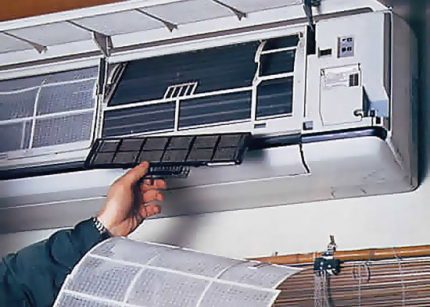
The most important part is Freon system refueling. Even if the owner of the apartment did all the other work on his own, let an experienced master do this step, practice shows that it is more reliable.
Incorrect installation can significantly reduce the efficiency of the air conditioner, and it is the most common cause of breakdowns of this equipment.
It is very important to choose the right place for the indoor unit. If the cold stream is directed to a nearby surface, the equipment will not work correctly, and the cooled air will spread unevenly throughout the room. The operation of the outdoor unit is usually accompanied by condensation.

Care should be taken to remove this moisture with a special tube so that water does not flow down the wall. If the split system is mounted correctly, it remains to ensure its normal operation. It is recommended to set the cooling temperature within 21-23 degrees.
Lower temperatures are also acceptable, but this mode of operation creates an additional load on the system. In addition, too much difference between the temperature inside and outside the building can have undesirable health effects.
The indoor unit is best installed in such a way as to prevent direct exposure to the sun.
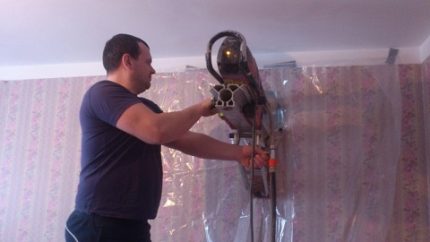
In addition to the danger of overheating, there is a possibility that bright light can become an obstacle to the LED signal. To increase the life of the system, it is better to close windows and doors during its operation. Of course, periodically, you need to ventilate your home or purchase a model that takes air from the street.
Equipment should be protected from excessive heat or electromagnetic effects. Once every six months clean filters. The outdoor unit must be protected from the weather.
Danger to equipment is represented by power surges if the difference between the nominal and real indicators exceeds 15% of the standard.
Conclusions and useful video on the topic
A clear description of the principles of operation of such a system can be found here:
This video describes the practical experience of using a split system with heating:
Reliability of split systems and ease of operation have made them an extremely popular option for air conditioning in residential premises. With proper installation and compliance with working conditions, such equipment can function flawlessly for a very long time.
Still can't choose a suitable split system? Or can you complement our material with practical advice? Please leave your comments, ask questions, share your experience in the block under the article.

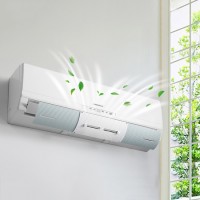 What is a multi split system: principle of operation + installation and connection rules
What is a multi split system: principle of operation + installation and connection rules  What is a channel split system: varieties and device options
What is a channel split system: varieties and device options 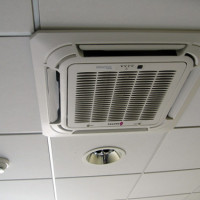 What is fan coil: principle of operation and installation rules for a fan coil
What is fan coil: principle of operation and installation rules for a fan coil 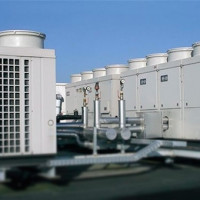 Chiller-fan coil system: operating principle and arrangement of the thermoregulation system
Chiller-fan coil system: operating principle and arrangement of the thermoregulation system 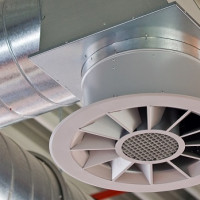 Comparative review of ventilation and air conditioning systems
Comparative review of ventilation and air conditioning systems 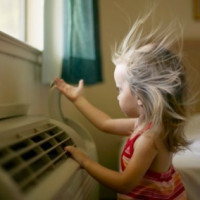 Maintenance of split systems: do-it-yourself cleaning, repair and refueling of HVAC equipment
Maintenance of split systems: do-it-yourself cleaning, repair and refueling of HVAC equipment  How much does it cost to connect gas to a private house: the price of organizing gas supply
How much does it cost to connect gas to a private house: the price of organizing gas supply  The best washing machines with dryer: model rating and customer tips
The best washing machines with dryer: model rating and customer tips  What is the color temperature of light and the nuances of choosing the temperature of the lamps to suit your needs
What is the color temperature of light and the nuances of choosing the temperature of the lamps to suit your needs  Replacement of a geyser in an apartment: replacement paperwork + basic norms and requirements
Replacement of a geyser in an apartment: replacement paperwork + basic norms and requirements
I always face the problem of heat in the house in the summer.To solve this problem I had to buy an air conditioner, namely a split system. I got acquainted with the principle of work in advance of purchase. To connect the two parts of the system, I had to make a hole in the wall, and connect the pipe 2 parts of the split system. The most important thing is that moisture does not get in, otherwise everything can fail. Thus, after installing the split system, the problem of high temperature in the house disappeared.
There are significant advantages and disadvantages. I always draw the attention of the client to the minuses so that there will not be any discontent in the future: restriction on the installation site, restrictions on power, I indicate the cooling area, I immediately say how the split system will fit into the design of the room (how much it will look aesthetically and beautifully), that drafts may occur.